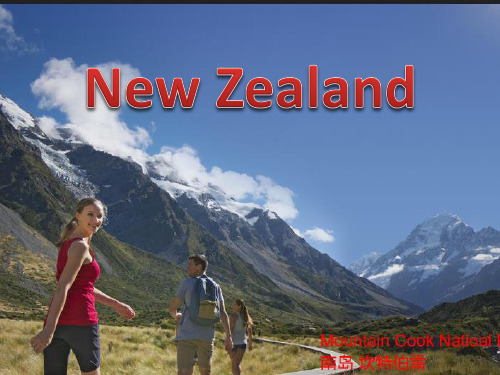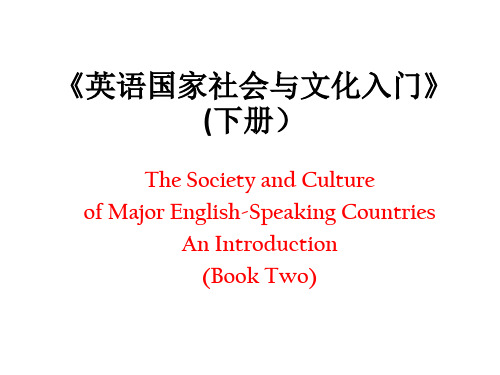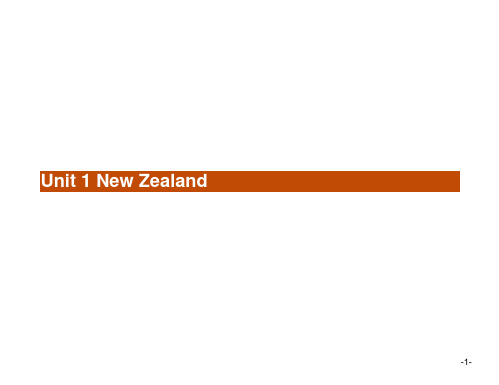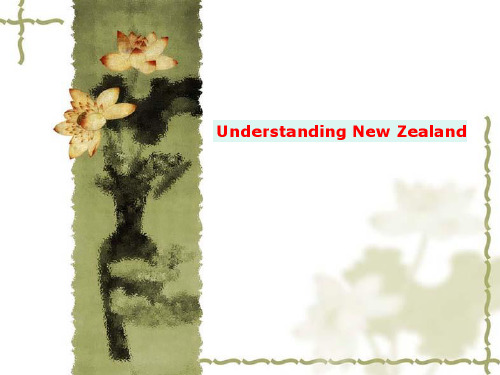新西兰 英语国家文化的选修课 课件
英语国家社会与文化New zealand新西兰

Environmental Issues
Introduced animals have seriously affected native fauna and their habitat.(外来物种的生物入侵) New Zealander’s environmental awareness is reflected in legislation. In 1991, the Resource Management Act(资源管理法) came into effect. It was the first piece of environmental legislation of its kind in the world.
Local Government
• There are three levels of local government, and a ratepayer may deal with all three in everyday life. • Regional councils(地方民防) have an environmental overview and are responsible for resourse management. • Territorial authorities(土地局) are City Councils, District Councils and the Chatham Island Country Council. • Community boards(社区委员会) promote local community interests and may have other powers than the local government give them.
《新西兰的英文》课件

The vocabulary of New Zealand English is influenced by the unique history, culture, and geography of the country. New Zealanders tend to use words that are specific to their local context, such as Māori loanwords like " Pā" (a Māori fortification) or "Kākā" (a native parrot).
"Ta"
A common New Zealand expression used as a shortened form of "thank you".
新西兰文化部分_英文

3、免费教育
小学中学免费教育,国立大学只需交象征性的低学费,定 居两年后可以享受学生津贴,其金额需根据学生家庭人数,住 房费用等补贴,足够全家生活开销。(每10周学习,2周放假)
4、166个国家或地区免签入境
成为新西兰公民后可免签证进入欧美发达国家。可以自动 得到澳大利亚定居权、工作权,享受除失业救济外的所有澳大 利亚公民应享受的福利。可以到英国工作。退休后可以到英国、 荷兰、比利时等国居住(退休金由新西兰政府支付)。
last
Hongi(毛利族人的以鼻相触的见面 礼): touching nose etiquette
The traditional Maori welcome is called a powhiri(欢迎仪式), this involves a hongi which is a warm greeting that involves pressing noses as opposed to a kiss.
In Classic Maori society ,the male was the fully tattooed flourishing decorated cheeks, chin, nose and forehead as well as buttocks(臀部)and thighs. Tattooing was a sign of status(身份的象 征) and far from simply decorating the face. In general,a man has a higher status if he has a more complex decorative(装饰性的) pattern on his face .
• • • • MaoriCulture welfare of newzland Education food
新西兰介绍英文ppt08522

the play or movie, usually also divided into men's and
women's field. New Zealand people do not want to talk
about religion, domestic political and private affairs of
December 22, 1972, New Zealand and China established diplomatic relations.
精选可编辑ppt
3
国 旗
New Zealand's national flag is rectangular, and the ratio of length to width is 2:1. Its base is deep blue, above and to the left for the British flag. On the right is the fourth single edged with white five pointed star of red, four stars arranged asymmetrically. New Zealand is a member of the Commonwealth, "m" word patterns show that the traditional relations with Britain; four stars said the Southern Cross constellation, show that the country is located in the southern hemis精p选he可r编e辑, ppbtut also a symbol of independence and hope. 4
英语专业英美文化概况之新西兰NEWZEALAND

英语专业英美文化概况之新西兰NEWZEALANDU1 Land, People and HistoryⅠ. Choose the answer that best completes the statement or answers the question:1.Which of the following mountains is the highest in New Zealand?A AlpsB RuapehuC Southern AlpsD Mt. Cook2.In size, New Zealand is similar to ____A JapanB British IslesC Japan plus the British IslesD A & B3.The longest river of the country is ____A Waikato riverB Clutha riverC Rakaia riverD Wanganui river4.The largest city in New Zealand is ____A WellingtonB AucklandC ChristchurchD Dunedin5.New Zealand’s nearest large neighbor is ____A TongaB FijiC AustraliaD Argentina6.In April 2006, New Zealand became the first country to declare ____ as an official language.A EnglishB MaoriC sign languageD Polynesian language7.Which one of the following is the most common religion?A ChristianityB Roman CatholicC MethodistD Anglican8. Which country is the first one in the world to give women the right to vote?A AmericaB SwedenC AustraliaD New ZealandⅡ.Decide whether the following statements are true(T) or false(F):1. Maori people today resist adopting western life. ( )2. The North Island has been formed mostly by active volcanoes. ( )3. There are no nuclear power plants or weapons in New Zealand. ( )4. Because of the gold boom, people in the North Island have been more than in the South since 1896. ( )5. Wellington is the world’s largest Polynesian city. ( ) Ⅲ.Fill in the blanks:1. New Zealand is in the _________________________________2. The two main land masses in the country are _________________ and ___________________3. The first piece of environmental legislation ---_________________came into effect in 1991, in which ________________________ is reflected.4. New Zealand was settled over 1000 years ago by _________ from __________________ .5. In 1840, Maori chiefs signed the ______________________ to keep their ownership of the natural, and in return, to give up the right to govern to the __________________ .6. The national bird of NZ is _________________.7. In 1769, ________________ visited New Zealand and claimed it for Britain,U2 Political System, Education and EconomyⅠ. Choose the answer that best completes the state ment or answers the question:1.The two main parties in the House of Representatives are______A the Progressive Party and the Labor PartyB the Labor Party and the National PartyC the Green Party and the NZ First PartyD the United Future NZ Party and the National Party2.The Head of State of New Zealand is______A the Prime MinisterB the Governor GeneralC the British monarchD the Ombudsman/doc/189491683.html,cation in New Zealand is compulsory between the ages of ______A 5---15B 6---16C 7---17D 6---114. The economy of NZ largely relies on _______A overseas tradeB agricultureC fishingD forest5. The electricity in NZ mainly depends on_______A riversB geothermal steamC windmillsD natural gas6. Which one is not in the largest exporters of NZ?A meatB dairy productsC woolD woodⅡ.Decide whether the following statements are true (T) or false (F):1. New Zealand has no written constitution. ( )2. An Act of Parliament can become law without the Governor-General’s agreement.( )3. The largest school in NZ is the Correspondence School. ( )4. NZ is one of the world’s largest fishing areas. ( )5. About 70% of exports going to Pacific Rim members of the APEC grouping. ( )6. The sea food industry is the third biggest export earner. ( )7. NZ is the only one country in the world where farming is not subsidized by the state. ( ) 8. There are 20 forest parks, 7 inthe North Island and 13 in the South Island. ( ) Ⅲ.Fill in the blanks:1. Since 1950, Parliament has had a single chamber, the_____________________.2.The three levels of local government are ______________ , _____________and ______________ .3. New laws begin as documents called _______. Parliament considers several different types of bill in formal stages. If they pass through all those stages they become _________, called ______________________.4. NZ now has four major markets: ________, __________________, ________ and ________.5. Cereals such as wheat, barley and oats are grown in __________________; maize in ______.6. The pillar industries of NZ are _________. ____________,____________, ______________.。
新西兰文化(英文)PPT

英语国家社会与文化入门下册PPT教学课件-U1

Māoritanga
-the iwi: a Māori tribe, the main social organization in Māori society;
Left: Auckland, the largest city of New Zealand; Right: Wellington’s Beehive, the national symbol of executive power
• Climate and Wildlife
-the southern temperate latitudes midway between the Equator and the South Pole; -maritime climate; -seasons opposite to the Northern Hemisphere; - isolated from the rest of the world for 80 million years, New Zealand developed unique flora and fauna. -80% of the trees, ferns and flowering plants are endemic (found only in New Zealand); -6.2 million hectares of native forest
I. Land and Environment
• Georgraphy: “Aotearoa”--“Land of the long white cloud”
英语国家文化概况Chapter14课件

Foreign Language Teaching and Research Press
Foreign Language Teaching and Research Press
1.2 Geographic Regions and Climate
❖ 2. How many geographic regions can Canada be divided into?
▪ The Atlantic Region cold winter, hot summer, sparse precipitation
▪ The Central Region ▪ The Prairie Region
a continental climate
▪ The Pacific Region
a moderate climate
Foreign Language Teaching and Research Press
II
History
2.1 Discovery and Exploration 2.2 European Settlement 2.3 British Canada 2.4 Canadian Nation 2.5 Canada Since the 1980s 2.6 Exercise
1.3 Major Cities—Toronto (cont.)
the tallest tower in the western hemisphere, the world's second tallest freestanding structure
Foreign Language Teaching and Research Press
Foreign Language Teaching and Research Press
高二英语选修七课件ModuleEthnicCultureCulturalreadingandvoca

"joyful"等
反义词对比
反义词的定义:意义相反的词 反义词的作用:帮助理解和记忆词汇 反义词的举例:例如,big和small,long和short 反义词的学习方法:通过比较和对比来记忆词汇
4
文化背景介绍
民族文化的起源和发展
发展:随着社会的进步和科技的 发展,民族文化也在不断地演变 和丰富。
起源:不同民族文化的形成和发 展,受到地理环境、历史背景、 宗教信仰等多种因素的影响。
特点:每个民族都有自己独特的文 化传统和特色,这些特点反映了该 民族的历史、信仰、价值观和生活
方式。
交流:不同民族之间的文化交流 和融合,促进了文化的多样性和
发展。
民族文化的特点和影响
民族文化的多样性:不同民族有不同的文化特点,如语言、服饰、饮食、习俗等。
民族文化的传承:通过家庭、学校、社会等途径,将民族文化代代相传。
民族文化的影响:民族文化对个人、社会和国家都有深远的影响,如价值观、行为方 式、社会结构等。
民族文化的保护:保护和传承民族文化,有助于维护国家文化多样性和民族认同感。
细节信息理解
阅读材料中的细节信息: 时间、地点、人物、事件
等
理解细节信息的重要性: 有助于理解文章的主旨和
情感
细节信息的作用:使文章 更具体、生动、真实
如何寻找细节信息:仔细 阅读文章,注意关键词和
短语,结合上下文理解
推理判断题解析
阅读理解题的特点:需要根据 文章内容进行推理和判断
解题步骤:仔细阅读文章,理 解文章大意;分析题目要求, 找出关键信息;结合文章内容, 进行推理和判断;选择答案, 并检查是否符合题意。
高一英语New Zealand课件 人教

Clean sand beaches
Discussion
After you learned the text, what’s your idea about the environment ?
1、Do exercise 1—4 of Post reading
2、After class you should learn the text again until you can retell it.
New Zealand
Hot springs
Heat of the hot springs
Europeans
England
2.Describe the location of the following lands, seas and cities in relation to New Zealand. A.The Pacific Ocean B.The Tasman Sea C.Wellington D.Auckland E.Christchurch
Reading
`Read the text carefully and fill in the blanks in the form.
location
two large islands
the ocean to the north and east
the sea to the south and west
Homework
9、静夜四无邻,荒居旧业贫。。*** 10、雨中黄叶树,灯下白头人。。**** 11、以我独沈久,愧君相见频。。***** 12、故人江海别,几度隔山川。。**** 13、乍见翻疑梦,相悲各问年。。***** 14、他乡生白发,旧国见青山。。**** 15、比不了得就不比,得不到的就不要。。。***** 16、行动出成果,工作出财富。。*** 17、做前,能够环视四周;做时,你只能或者最好沿着以脚为起点的射线向前。。**** 9、没有失败,只有暂时停止成功!。*** 10、很多事情努力了未必有结果,但是不努力却什么改变也没有。。**** 11、成功就是日复一日那一点点小小努力的积累。。***** 12、世间成事,不求其绝对圆满,留一份不足,可得无限完美。。**** 13、不知香积寺,数里入云峰。。***** 14、意志坚强的人能把世界放在手中像泥块一样任意揉捏。**** 15、楚塞三湘接,荆门九派通。。。***** 16、少年十五二十时,步行夺得胡马骑。。*** 17、空山新雨后,天气晚来秋。。**** 9、杨柳散和风,青山澹吾虑。。*** 10、阅读一切好书如同和过去最杰出的人谈话。**** 11、越是没有本领的就越加自命不凡。***** 12、越是无能的人,越喜欢挑剔别人的错儿。**** 13、知人者智,自知者明。胜人者有力,自胜者强。***** 14、意志坚强的人能把世界放在手中像泥块一样任意揉捏。**** 15、最具挑战性的挑战莫过于提升自我。。***** 16、业余生活要有意义,不要越轨。*** 17、一个人即使已登上顶峰,也仍要自强不息。****
英语国家概况New-Zealand

The government and various organizations provide scholarships and financial aid to international students studying in New Zealand. These can cover tuition fees, living expenses, and other costs associated with studying abroad.
Auckland's Queen Street and Victoria Street are popular shopping areas, offering a range of international and local brands. Wellington's Lambton Quay is also a popular shopping destination.
New Zealand Tourism
CATALOGUE
04
Mount Cook National Park
A popular destination for hikers and nature lovers, offering breathtaking views of the Southern Alps.
Overview of English speaking countries - New Zeala
Introduction to New ZealandNew Zealand cultureEducation in New ZealandNew Zealand TourismNew Zealand Life
新西兰毛利文化ppt英文课件

Culture of New Zealand:Maori
• The Maori are the native people living in the New Zealand and comprise about 14 percent of the country's population.They have their own typical Maori culture,which refers to all the elements of the rich culture heritage of the indigenous(本土的) people in New Zealand,including their language,customs and tradition.They have their own language,reo Maori,which is also one of the offical languages of New Zealand.
Haka dance
Haka dance
• The haka ,which was originally used as a WAR CRY and as a preparation before battle,is characterized by heavy stomping(跺脚), loud chanting(喊叫), and aggressive body movements.The haka is the most widely known performance which is used by the All Blacks (New Zealand's national rugby team) to challenritanga(毛利人文化和风俗习惯)
新西兰文化(英文)

Culture of New ZealandI.New Zealand General CultureThe culture of New Zealand is largely inherited from British and European custom, interwoven with Maori and Polynesian tradition. (1) An isolated Pacific Island nation, New Zealand was comparatively recently settled by humans. Initially Maori only, then bicultural with colonial and rural values, now New Zealand is a cosmopolitan culture that reflects its changing demographics, is conscious of the natural environment, and is an educated, developed Western society.More recently, New Zealand culture has been broadened by globalization and immigration from the Pacific Islands, East Asia and South Asia. European and Maori remain the two largest ethnicities, but the large Polynesian population in Auckland has prompted the observation that Auckland is now the largest Polynesian city in the world. However, the country outside of Auckland is still much less heterogeneous, with big parts of the South Island remaining predominantly of European descent.New Zealand marks two national days of remembrance, Waitangi Day and ANZAC Day, and also celebrates holidays during or close to the anniversaries of the founding dates of each province. The national anthem, "God Defend New Zealand" is often sung with alternating Maori and English verses. Many citizens prefer to minimize ethnic divisions, simply calling themselves New Zealanders or Kiwis.II.Maori CultureMaori culture has predominated for most of New Zealand's history of human habitation. Maori voyagers reached the islands of New Zealand some time before 1300, though exact dates are uncertain. The Maori settled the island and developed a distinct culture.Maori oral history tells of a long voyage from Hawaiki in large ocean-going canoes. Maori mythology is a distinctive corpus of gods and heroes, sharing some Polynesian motifs. Some notable figures are Rangi and Papa, Maui, andKupe.Over the ensuing centuries of Maori expansion and settlement, Maori culture diverged from its Polynesian roots. Maori established separate tribes, built fortified villages, hunted and fished, traded commodities, developed agriculture, arts and weaponry, and kept a detailed oral history. Regular European contact began approximately 200 years ago, and British immigration proceeded rapidly during the nineteenth century. (2)The colonists had a dramatic effect on the indigenous Maori, bringing religion, technology, and the English language. In 1840 Maori leaders signed the Treaty of Waitangi, intended to enable the tribes to live peacefully with the colonists. However after several incidents, the treaty was ignored and the New Zealand land wars broke out from 1845, with Maori suffering a loss of land and identity, while also increasingly becoming a minority group over the following century. Despite such setbacks, Maori culture has regained much of its lost influence in recent decades. III.New Zealand European CultureNew Zealand European culture derives mainly from that of the British settlers ,its people called Pakeha who colonized New Zealand in the nineteenth century. Although it is recognizably related to British culture, it has always had distinct differences, and these have increased as time has gone on. Things which distinguish European culture from British culture include higher levels of egalitarianism, anti-intellectualism, and the idea that most people can do most things if they put their minds to it. Within European culture are sub-cultures derived from Irish, Italian and other European groups, as well as various non-ethnic subcultures. (3) It has been claimed that Pakeha do not actually have a culture, or if they do it is not a distinct one. Part of the problem is that high culture is often mistaken for culture in general, and the lack of recognition historically given to New Zealand's artists, writers and composers is seen as evidence of a lack of culture.IV.Relationship Between Maori Culture And New Zealand European CultureThese two kinds of culture in New Zealand are not totally independent. In fact, Maori borrow from European culture, so do European culture, they interact each other. But during this process, there is always existing a lot of conflicts, sometimes they all hold their own stance, reject to receive the other one’s culture. Gladly, the situation changes better between them, they have realized how to respect each other, and how to get along with each other harmoniously.On one hand, since the early stages of colonization, Maori have been receptive adopters of aspects of European culture. From the 1830s many Maori converted to Christianity and in the process learned to read and write, to the extent that it has been claimed that in mid nineteenth century New Zealand, Maori were more likely to be literate than Pakeha. A number of religions, such as Pai Marire and Ringatu, arose in the nineteenth century, blending Maori tradition and Christianity (4). Similarly Maori traditional chants were put to Victorian music, or written to European tunes, European designs and metal tools adopted by carvers, altering their style and British fabrics and cloth, such as blanketing adopted to form new dress. The horse was adopted, particularly on the East coast. European tools and particularly weapons were frequently decorated with traditional motifs, for example wooden musket and rifle stocks acquired elaborate carving. From the 1820s Maori began building vessels in the European boat building tradition. Many of these activities were conducted in collaboration with Pakeha traders and settlers.From the 1860s, the adoption of Pakeha culture became less of a free choice as Pakeha began to outnumber Maori. A Pakeha-dominated parliament had free rein to pass legislation affecting Maori, such as the Native Schools Act which required English to be the dominant medium of instruction for Maori children. So, while majority of Maori encouraged their children to learn the English language and Pakeha ways of life in order to function economically and socially, Maori were pushed as well as pulled into changing culture. From the early twentieth century and especially from the 1970s, Maori began to protest against this Eurocentrism and demanded equal recognition for their own culture.One the other hand, since the late nineteenth century, Pakeha have used many ofits forms when they required something distinctively New Zealand. The most famous example of this is the haka of the All Blacks, a Maori posture dance which is performed before international rugby matches, there are many non-Maori Polynesian All Blacks, thus making this a multi-ethnic borrowing. However Pakeha artists such as Colin McCahon and Gordon Walters have also incorporated Maori motifs into their art, and a number of early Pakeha writers used Maori themes and topics in an effort to create an authentically New Zealand literature. The tourist industry has also made heavy use of Maori culture in an effort to present tourists with distinctly New Zealand experiences and items. This may show that Pakeha are not entirely confident that they have a culture of their own, or if they do, that it is interesting or distinct. Many Pakeha in other countries use Maori culture in order to express their New Zealandness, even if they take little interest in Maori while in New Zealand. An example of this is the mass haka which takes place in Parliament Square in London every Waitangi Day. Although Maori are generally involved, most participants are Pakeha.For many years Pakeha did not consult Maori over the use of their culture, and Maori generally did not protest loudly unless a symbol was being used in a particularly inappropriate way. From the 1970s, Maori began increasingly to object to Pakeha use of their culture, especially when this use was disrespectful or ignorant. One example of this is the 'haka party incident' of 1979. University of Auckland engineering students had a tradition of performing an obscene mock haka at graduation. After pleas from Maori students to discontinue the practice were ignored, a group assaulted the engineering students. They were later charged with assault but defended by Maori elders who testified that the engineers' haka was deeply offensive.Most Pakeha are now more respectful of Maori culture and often consult Maori before using Maori cultural forms. However despite some attempts to copyright cultural intellectual property this does not always occur and forms are still sometimes used in inappropriate ways.V.Other Contents in New Zealand CultureA.Customs in New ZealandIn New Zealand, when people meet or say goodbye, they all shake hands with each other. In common, they have straight eye contact and shaking hands tightly. A man should wait for a woman’ hand first, besides this, bowing and heading up are also their courtesy. At the fist meet, people who have the same identity call each other last name, and add Mr./Miss, after they are familiar with each other, they will call him by his first name. And Maori still has strong traditional customs. When they meet the honored guests, both parties should touch the tip twice or three times. According to the custom, it is said that the longer you touch the nose, the higher the treatment, the more popular.New Zealanders often have strong time concept, date shall be agreed in advance, be punctual for appointment. Guests can arrive a few minutes early to show their respect to the host. Their daily talks always refer to climate, sports, domestic and foreign political, tourism and so on. Avoid about personal things, such as religion, race, and so on. Meeting a visitor is generally in the office, the person who is invited to visit a New Zealand home can give the host a box of chocolate or a bottle of whisky, and give the hostess a bunch of flowers, the present shouldn’t be too much or too expensive.Because most local residents are English descents, therefore, the spread of custom here is English body language and gestures. They are dissatisfied with the hubbub and striking an attitude excessively. Chewing gum or using toothpicks in public are considered not civilized behaviors. New Zealanders take European dining way, always a fork in left hand, a knife in right hand.New Zealand life rhythm is slower, people’s life is carefree. For different classes, the opening of the market and the rich products give them a range of options, but seen from an overall consumption level, New Zealanders pursue high-grade goods, shopping tend to famous brands.New Zealanders’characters are formal, serious, even watching a movie, often separate men from women to a different time. Restrictions on alcohol is strict, the restaurant licensed to sell alcohol can only sell wine, in the restaurant which can sell alcohol, the guest must buy a dinner so he is allowed to drink a cup of. However, beersales in New Zealand are quite large, the fifth, it is to say that per person drink 110 liters of beer per year.B.Convention in New ZealandNew Zealand’s legal age of marriage is 16 one full year of life, but before 18 one full year of life, it needs parents’agreement and guardianship. For Maori, before puberty, they are just naked in front of their mothers, they can have a trial marriage, if they are satisfied with each other after living together and getting their parents’ agreements, as long as the woman live in the man’s home a night ,they are married. And another thing for marriage, December 9, 2004, more than half of New Zealand parliament voted to pass the homosexuals and cohabitation of citizens who may enjoy the combination with legal couples in equal legal status.Under the climate condition, in most occasions, people can take leisure clothing, most restaurants and snacks places are accepted guests with leisure clothing. Men generally need not wear a suit and tie, only a few top formal restaurants of the big city and bar exception.In New Zealand, there are 14 manors for vacation listed in the Small Luxury Hotels of the World. What’s more, many other throughout New Zealand delicate hotels provide high quality accommodation, which usually located an untraversed region. Now more and more hotels provide spa.(1)/wiki/Culture_of_New_Zealand访问时间2011,11,22,18:19(2)/wiki/Culture_of_New_Zealand访问时间2011,11,22,18:19(3)/wiki/Culture_of_New_Zealand访问时间2011,11,22,18:46(4)/wiki/Culture_of_New_Zealand访问时间2011,11,22,18:46(5)/view/10151.htm访问时间2011,11,22,19:00新西兰文化-百度百科(6)/view/497e67ec5ef7ba0d4a733bf5.html访问时间2011,11,22,19:00婚礼习俗(7)《新西兰社会与文化》,王素华主编,武汉大学出版社,2007(8)《新西兰:历史、民族与文化:Its History, People and Culture》,赵晓寰,乔雪瑛著,复旦大学出版社,2009(9)《太平洋上的璀璨明珠:新西兰》,赵友斌,林知著,四川大学出版社,2000。
新西兰英语国家概况(课堂PPT)

No written constitution; political system closely modeled on UK
Political Parties
Two-party system: the National Party and the Labor Party
41
46
Voted for Change: John Key celebrates National Party's
golden fleece: farming industry
crown: a commonwealth country
Māori warrior & Māori ceremonial spear
two hammers: mining & industry
a scroll 5
National Anthem (1)
area are numerous geysers and hot springs.
20
Lake Taupo
21
The Clutha: the largest river in New Zealand 22
The Clutha
23
Lady Knox Geyser: The north central region of North Island is an area of active volcanism. besides three active volcanoes, geysers, mud pools, and hot springs2.4
Population 4,173,460 (July 2008 est.)
Ireland: Area: 70,282 sq. km Population: 4,156,119 (July 2008 est.)
英语人教选修11课件:Unit1NewZealand

-1-课标导航文本感知谈论地理特征、气候、文化、人口等(Talking about geographical features,climate,culture,population,etc)The North Island has a range of mountains running through themiddle of the island,with gently sloping farmland on either side. It rains very heavily in this area,which has an annual rainfall of over 7,500 mm,an ideal environment for spectacular forests andfarming.Most moved to the North Island,where the climate was better for growing sweet potatoes and fern roots for food・课标导航文本感知课标导航文本感知课标导航文本感知Y 観鬆H trnI •阅读NEW ZEALAND LAND OF THE LONG WHITE CLOUD,完成下列问题。
1 .There are lots of earthquakes and volcanoes in New Zealand becauseA. New Zealand has two tectonic plates which are constantly movingB. New Zealand has many volcanoesC. New Zealand sits on two tectonic plates which are seldom movingD. New Zealand sits on two tectonic plates which are constantly moving2. The Central Plateau is CA. on one side of the North IslandB. on one side of the South IslandC. in the centre of the North IslandD. in the centre of the South Island课标导航3.Most Maori people came to live in New Zealand in about E ・A.1000 ADB.1000 AD-1200 ADC.1000BCD.1200 BC-1000BC4.What can we know from this passage? AA.The environment of New Zealand was changed greatly by English settlers ・B.The Maori signed a treaty with Britain and lived peacefully from then on.C.The Maori and Europeans fought only between 1860-1872.D.The Southern Alps is on the North Island・5.What can we infer from this passage? CA.The Plateau is the site of sweet potatoes.B.The English settlers called their new home Aotearoa・C.The Maori people fought with each other.D.To protect themselves,the people began to live in houses.Y観鬆H口•阅读NEW ZEALAND TRAVEL GUIDE,完成下列问题。
新西兰(英语社会文化课课件)

English and Maori are the official languages of New Zealand. Maori became an official language in 1987.New Zealand English is close to Australian English in pronunciation, but has several subtle differences.
Political System
The politics of New Zealand takes place in a framework of a parliamentary representative democratic monarchy.
Currency
The New Zealand dollar (currency code NZD)is the currency of New Zealand. It is normally abbreviated with the dollar sign $, or alternatively NZ$ to distinguish it from other dollar-denominated currencies.
Cliocated in the Southern Temperate Zone, south of the tropics. It has a mild climate with four seasons. The warmest months of summer are January and February and the coldest months of winter are June and July.
- 1、下载文档前请自行甄别文档内容的完整性,平台不提供额外的编辑、内容补充、找答案等附加服务。
- 2、"仅部分预览"的文档,不可在线预览部分如存在完整性等问题,可反馈申请退款(可完整预览的文档不适用该条件!)。
- 3、如文档侵犯您的权益,请联系客服反馈,我们会尽快为您处理(人工客服工作时间:9:00-18:30)。
MAORI CULTURE
• The Maori are the indigenous people of New Zealand,they are Polynesian and comprise about 14% of the country’s population.Tereo Maori is the native language which is related to Tahitian and Hawaiian.
New Zealand
Brief Introduction
奥克兰(Auckland)是新西兰第一大城市,全国工 业、商业和经济贸易中心,集中全国近四分之一的
人口。
公元14世纪,毛利人从波 利尼亚来到新西兰定居, 成为新西兰最早的居民,
并用波利尼亚语 “aotearoa”做了它的名字,
意思是“白云朵朵的绿 地”。此后英国向这里大 批移民并宣布占领新西兰,
Maori Carving
LANGUAGE
• 新西兰约四分之一的毛利人 使用“蒂雷欧毛利语” (Te reo Maori)。使用这 种语言的人大约有一半不到 25岁。这是种波利尼西亚 语言(类似其它大洋洲语, 如夏威夷语和大溪地语), 有一种独特的诗感和音乐性。 毛利语是新西兰的官方语言 之一。
Thank u for listening
FOOD
• New Zealand Food is similar to Australian food:both their roots are in British and Irish foods.
• There are differences,however.Maoris(indigenous New Zealanders) and immigrants from other Pacific Island make up a significant proportion of the population.
把海岛名字改成英文 “Zew Zealand”.新西兰于 1947年完全自主,仍为英
联邦成员。
CUculture is rich and diverse due to the blending of Polynesian and European cultures.The influence of Maori,Pacific Island,European and Asian cultures makes New Zealand a colourful and vibrant place with many different customs and food to enjiy.
• As a globle and regional power,New Zealand’s secondlargest trading pratner,and a major source of migrants,students and tourists,China is important to New Zealand as a bilateral,regional and multilated partner.
Lemon&Paeroa---New Zealand’s world famous drink
Relationship with China
• New Zealand and China celebrated 38 years of diplomatic relations on 22 December 2010.The bilateral relationship has grown to become one of New Zealand’s most valuable and important.
• The China-New Zealand relationship is characterised by regular high-level contacts,an expanding range of official dialogue---both formal and informal,healthy and diversifying trade and economic flows in both directions,and strenghing people-to-people contacts.
